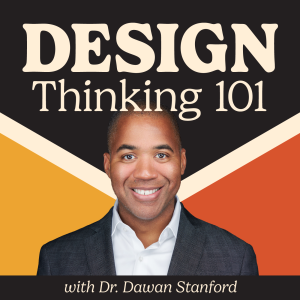
A Short Introduction to Design Thinking with Dawan Stanford — DT101 E32
 2019-10-01
2019-10-01
Welcome to the Design Thinking 101 podcast! I'm Dawan Stanford, your host. Today I'll be giving you a brief introduction to design thinking. It starts with a story about Doug Deitz. In 2012, Doug was a principal designer at GE Healthcare.
Doug designed a new MRI machine. One day, observing the new model in action at a hospital, Doug encountered a distraught child who had to undergo an MRI. He found out that over 80% of children had to be sedated to receive an MRI. Since he designed the original MRI machine, he felt responsible for this and wanted to remedy this issue for children. So, he spoke with teachers and other professionals who interact with children on a day-to-day basis, asking them how he could make their experience in an MRI machine less traumatic. As a result of those conversations, Doug and his team found a way to modify an MRI machine for children. They added stickers to the floor with water and rock on them. Covered the MRI with stickers that looked like wood planks and sails. Now, instead of a scary piece of hospital equipment, the MRI looked a lot like a pirate ship.. They even created a storybook that accompanied the themed MRI. Parents could read to their child the pirate ship adventure story ahead of their child’s scheduled appointment. These changes resulted in a decrease in the need for sedation from 80% to 27%.
Today, we explore how seeing the problem is an integral part of design thinking, and we’ll break down design thinking into process, methods, and mindset. The process is your step by step "rough" guide. With the methods, we have a bit more cohesion; design methods help us explore problems in specific ways, and guide us to ask questions in new ways in order to discover the right problems to solve. The mindset is something you have to practice your way into, in order to learn how to change your mindset.
At its most basic, design thinking is the discipline of finding human problems worth solving, and creating viable new options in response. In many ways, it's the discipline of helping people ask the right questions at the right time.
This episode also offers a definition design thinking that replaces creativity myths with truths about discipline and action. I break down the design process into Seeing, Solving, and Acting, and talk about why we should think about design from the perspective of the people we serve.
In This Episode
[01:26] Doug’s background in MRI science and his experience with a child getting an MRI.
[03:04] Over 80% of children need to be sedated to have an MRI or a CAT scan.
[06:15] Design thinking can be broken down into process, methods and mindset.
[07:07] What has design thinking given students, and how design thinking can shape curriculum and projects inside the classroom.
[08:02] The definition of design thinking.
[09:57] Creating viable new offerings and what is defined as “new”?
[12:11] Breaking down the design process into its three main components: seeing, solving and acting.
[15:09] Responses generated from a fixed mindset in opposition to the responses from a growth mindset.
[16:51] Everything is a prototype and designers are open to questioning how things work.
[20:17] What Doug was Seeing as he redesigned the children’s MRI experience.
[22:54] Delivering solutions based on what you are seeing.
Links and Resources
Elon By Design and The Center for Design Thinking, Elon University
Fluid Hive
Dawan Stanford on Twitter
Design Thinking 101 Podcast on iTunes, and on The Podcast App
Transforming healthcare for children and their families: Doug Dietz at TEDxSanJoseCA 2012
Ten Types of Innovation
More Episodes
Create your
podcast in
minutes
- Full-featured podcast site
- Unlimited storage and bandwidth
- Comprehensive podcast stats
- Distribute to Apple Podcasts, Spotify, and more
- Make money with your podcast
It is Free
- Privacy Policy
- Cookie Policy
- Terms of Use
- Consent Preferences
- Copyright © 2015-2024 Podbean.com





